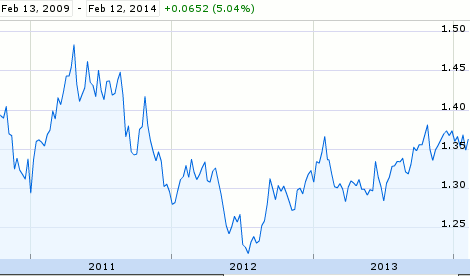This is an old revision of the document!
Table of Contents
Nominal Exchange Rate
The nominal exchange rate is the number of units of the domestic currency that are needed to purchase a unit of a given foreign currency. It can also be seen as the price of an unit of foreign currency, in terms of the local currency.
If we need to give 1.35 dollars to buy one Euro, the exchange rate is 1.35 EURUSD
It's called nominal because it doesn't take the purchasing power into account. The real exchange rate take prices of goods and services into account.
The exchange rate has an influence in the real economy through various channels. It affect exports and imports, prices, capital flows and investment.
Evolution of the EURUSD exchange rate

Fluctuations of the Nominal Exchange Rate
The nominal exchange rate is a price. It's determined by supply and demand.
Imports and Exports
When a company imports goods from another country, it's purchasing foreign currency. When a local company exports goods or services to another country, usually it sells the earnings to pay salaries and other expenses in the local country. Imports increase the demand for foreign currency, while exports increase the supply of foreign currency.
Capital Markets
When investors decide to purchase stocks, bonds or other financial instruments, they can not only buy local assets, but also foreign assets. When investors buy foreign assets, they are demanding foreign currency. When foreing investors buy local assets, or when local investors bring their money back, they are demanding local currency.
Capital markets play an important role in the exchange rate. Interest rates differentials can be an important factor in the determination of the nominal exchange rate.
Central Banks
Central Banks can play an important role in the nominal exchange rate. Big countries like China, and smaller countries like Argentina, have central banks that intervene directly in the forex market, puchasing and selling foreign exchange . But the European Central Bank and the Federal Reserve also play an important role, by periodically adjunting the interest rate of government bonds.
Nominal Effective Exchange Rate (NEER)
The exchange rate can be calculated using only two countries or using more than two countries. When only two countries are used for the calculation of the nominal exchange rate, it's called “bilateral”. When multiple countries are used for the calculation, it's called multilateral.
The nominal effective exchange rate (NEER) takes multiple countries into account. Each country can be weighted by the volume of it's trade.
For example, the European Central Bank (ECB) uses 19 bilateral euro exchange rates to calculate the Nominal Effective Exchage Rate of the euro. It choses 19 trading partners of the EU. Countries with more trade whith the EU have more weight: China, United States and United Kingdom are the most important trading partners.
http://www.ecb.europa.eu/stats/balance_of_payments_and_external/eer/html/index.en.html
The Nominal Effective Exchange Rate (NEER), together with the Real Effective Exchange Rate (REER), are commonly used as indicators of external competitiveness.
The Nominal Exchange Rate vs the Real Exchange Rate
The nominal exchange rate measure relative prices of currencies, while the real exchange rate measure relative prices of goods between countries.
The real exchange rate is the price of foreign goods, expressed in local goods. Mathematically, it's the foreign price index times the nominal exchange rate, divided the local price index:
Real Exchange Rate = EP*/P
Where:
E: nominal exchange rate
P*: foreign price index
P: local price index
Nominal Exchange Rate
Table
Domestic Currency per U.S. Dollar, End of Period| Country | </tr> <tr><td>Mexico</td> </tr> <tr><td>United Kingdom</td> </tr> <tr><td>Brazil</td> </tr> <tr><td>China</td> </tr> <tr><td>India</td> </tr> <tr><td>Japan</td> </tr> <tr><td>Canada</td> </tr> </table>
|---|
Discussion